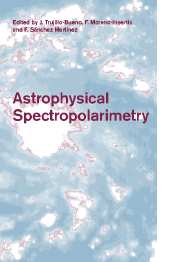Book contents
- Frontmatter
- Contents
- Participants
- Group Photograph
- Preface
- Foreword
- Acknowledgements
- The Physics of Polarization
- Polarized Radiation Diagnostics of Solar Magnetic Fields
- Polarized Radiation Diagnostics of Stellar Magnetic Fields
- Polarization Insights for Active Galactic Nuclei
- Compact Objects and Accretion Disks
- Astronomical Masers and their Polarization
- Interstellar magnetic fields and infrared-submillimeter spectropolarimetry
- Instrumentation for Astrophysical Spectropolarimetry
Preface
Published online by Cambridge University Press: 21 May 2010
- Frontmatter
- Contents
- Participants
- Group Photograph
- Preface
- Foreword
- Acknowledgements
- The Physics of Polarization
- Polarized Radiation Diagnostics of Solar Magnetic Fields
- Polarized Radiation Diagnostics of Stellar Magnetic Fields
- Polarization Insights for Active Galactic Nuclei
- Compact Objects and Accretion Disks
- Astronomical Masers and their Polarization
- Interstellar magnetic fields and infrared-submillimeter spectropolarimetry
- Instrumentation for Astrophysical Spectropolarimetry
Summary
Most observational work in astrophysics has so far been carried out mainly on the basis of the intensity of the radiation received from the object observed as a function of wavelength. However, an important and frequently overlooked aspect of electromagnetic radiation is its state of polarization, which is related to the orientation of the electric field of the wave. The state of polarization can be conveniently characterized in terms of four quantities that can be measured by furnishing our telescopes with a polarimeter. These observables are the four Stokes parameters (I, Q, U, V) which were formulated by Sir George Stokes in 1852 and introduced into astrophysics by the Nobel laureate Subrahmanyan Chandrasekhar in 1946. A quick, intuitive definition of the meaning of these four parameters can be obtained from Figure 1 of the chapter by Prof. Landi Degl'Innocenti in this book, which we borrowed for the poster announcing the Twelfth Canary Islands Winter School on Astrophysical Spectropolarimetry.
In physics laboratory experiments, where the magnetic field is known beforehand, the observed polarization signals are used to obtain information on the atomic and molecular structure of the system under study. In astrophysics we have the inverse problem, the magnetic field being the unknown quantity. To obtain information about cosmic magnetic fields, therefore, we have to learn how to interpret spectropolarimetric observations correctly by resorting to our knowledge of atomic and molecular physics.
- Type
- Chapter
- Information
- Astrophysical Spectropolarimetry , pp. xi - xiiPublisher: Cambridge University PressPrint publication year: 2001



